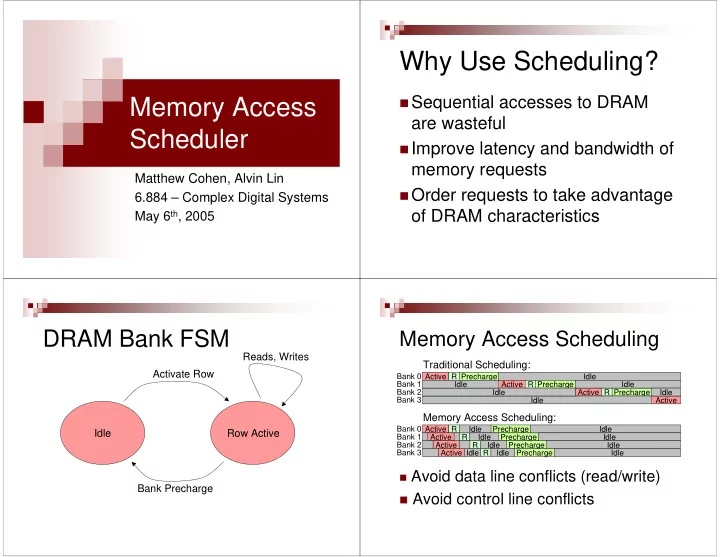

Why Use Scheduling? � Sequential accesses to DRAM Memory Access are wasteful Scheduler � Improve latency and bandwidth of memory requests Matthew Cohen, Alvin Lin � Order requests to take advantage 6.884 – Complex Digital Systems of DRAM characteristics May 6 th , 2005 DRAM Bank FSM Memory Access Scheduling Reads, Writes Traditional Scheduling: Activate Row Bank 0 Active R Precharge Idle Bank 1 Idle Active R Precharge Idle Bank 2 Idle Active R Precharge Idle Bank 3 Idle Active Memory Access Scheduling: Bank 0 Active R Idle Precharge Idle Idle Row Active Bank 1 Active R Idle Precharge Idle Bank 2 Active R Idle Precharge Idle Bank 3 Active Idle R Idle Precharge Idle � Avoid data line conflicts (read/write) Bank Precharge � Avoid control line conflicts
High-Level Architecture Instruction and Data Cache � Separate I- and D-caches Instructions � Fully parameterizable sizes Inst. Cache � Direct mapped caches Controller Memory CPU DRAM � Write-through, no-write-allocate Scheduler Data � Four words per cache line Cache Controller V Tag Word 0 Word 1 Word 2 Word 3 Data V Tag Word 0 Word 1 Word 2 Word 3 V Tag Word 0 Word 1 Word 2 Word 3 Incremental Design Non-Blocking Cache Architecture BUFTAG V0 V1 V2 V3 Tag0Tag1Tag2Tag3 � On cache load miss, � Fully blocking, single word per line BUFTAG V0 V1 V2 V3 Tag0Tag1Tag2Tag3 add request to Pending BUFTAG V0 V1 V2 V3 Tag0Tag1Tag2Tag3 � Fully blocking, four words per line BUFTAG V0 V1 V2 V3 Tag0Tag1Tag2Tag3 Request Buffer (PRB) � Hit under miss � Place µP tag in Tag location, set Valid, issue read � Miss under miss request to scheduler with tag = PRB index � Necessary for full benefits of scheduling � If another read to same line, set tag and valid but no new read request � On return of data, match tag to PRB line, retrieve µ P tag of valid entries, return data to µ P
High-Level Architecture Non-Blocking Cache Architecture Instructions BUFTAG V0 V1 V2 V3 Tag0Tag1Tag2Tag3 � On cache store BUFTAG V0 V1 V2 V3 Tag0Tag1Tag2Tag3 Inst. request, search PRB BUFTAG V0 V1 V2 V3 Tag0Tag1Tag2Tag3 Cache Controller BUFTAG V0 V1 V2 V3 Tag0Tag1Tag2Tag3 � If already issued read Memory CPU DRAM Scheduler to this line, stall Data Cache Controller Data Scheduler Tasks Scheduler Overview � Cache misses are sent to the � Keep waiting buffers of pending memory requests scheduler � Prioritize accesses in waiting buffer � Scheduler is responsible for � Respect timing of the DRAM interfacing with the DRAM � Capture data coming back from DRAM � Requests may be honored out of � Keep the DRAM busy! order
Incremental Design Scheduler RTL Design Waiting Buffer � Blocking In-Order Scheduler Bank 0 Instructions � FIFOs as Waiting Buffers and In- Waiting Buffer Order Scheduling Bank 1 From Cache DRAM Controllers Waiting � Real Waiting Buffers and Data Buffer Bank 2 Interleaved Scheduling Back to Cache Waiting Controllers Buffer Bank 3 Infinite Compile Time Architectural Exploration � Scheduler exploded in complexity � Change cache size to adjust cache miss percentage � Huge amount of combinational logic � Change PRB size to allow for scheduling � Memory access scheduling is a optimization difficult problem � Larger sizes should yield better results but � DRAM is not designed to work easily higher cost with scheduling
Total Time to Make 6000 Random Accesses to 512 Addresses Synthesis Results (Area = 196,117.6 µ m 2 ) 60000 50000 40000 Time (ns) 128 Byte Cache 30000 256 Byte Cache 512 Byte Cache 20000 10000 0 1 10 100 PRB Lines Conclusion Acknowledgements � 6884-bluespec � Memory becoming bottleneck for computer systems � 6884-staff � In-order memory access is simple in logic but wasteful in performance � group1, for teaching us � Memory access scheduling is much more how to use Vector, even if efficient in theory, but complex in you didn’t realize it… implementation
Recommend
More recommend